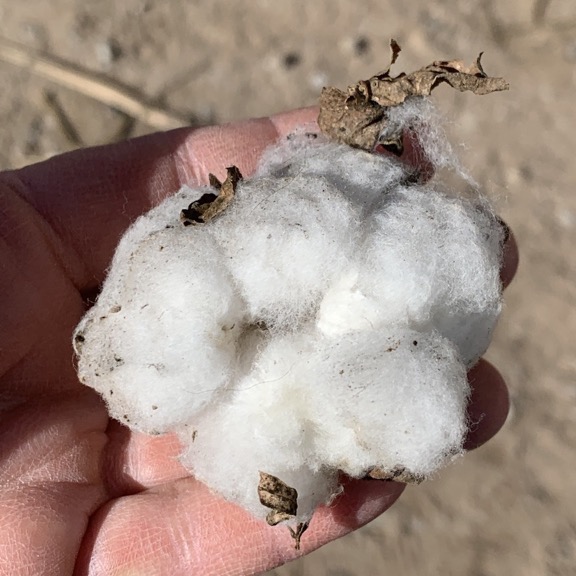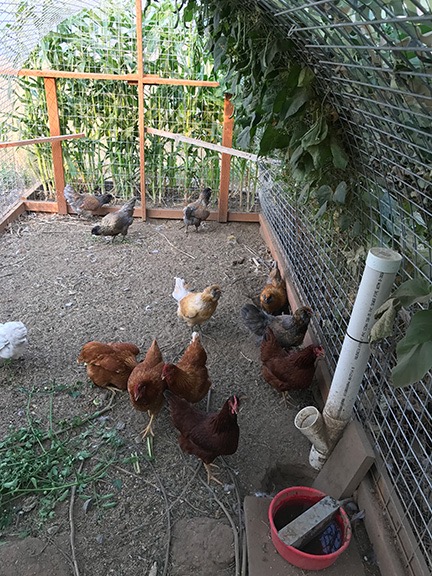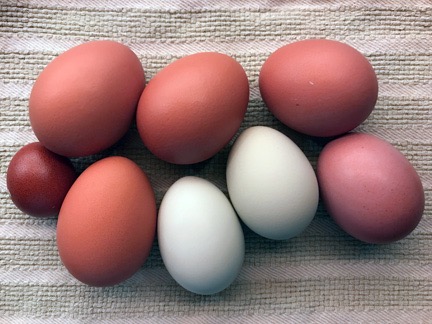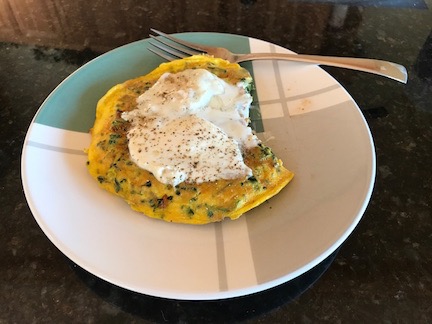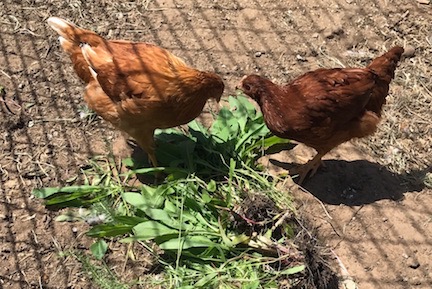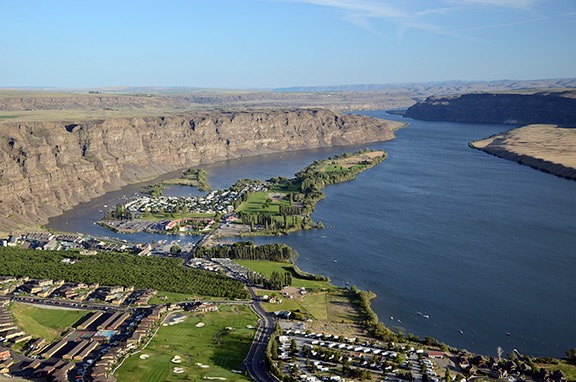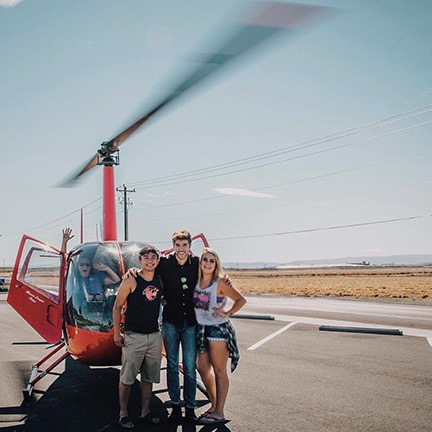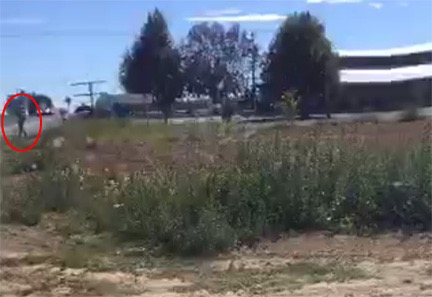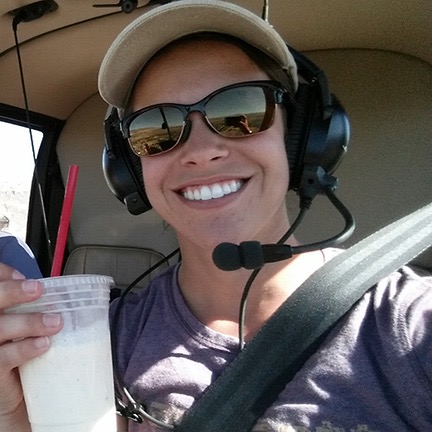A brief progress report.
After two flocks of chickens — the original flock and my replacement flock — being killed last year by a neighborhood dog (who will get shot if he steps foot in my yard again), I dove back into chicken rearing this summer by buying 18 pullet (female chicken) chicks with the attention of raising them for eggs and sale as laying hens.
Because I like colored eggs, I bought 12 Ameraucanas, which lay green, blue, or brown eggs. I also bought 3 Rhode Island Reds and 3 Golden Sex Links. This was in mid-March; they were just a few days old.
I built them a brand new chicken coop from scratch and moved them into it in May when they’d gotten too big for the stock tank I’d been raising them in in my garage.
I fed them chicken feed, chicken scratch, and kitchen scraps. They grew.
One of the Ameraucanas died. It happens sometimes. That left me with 17 chickens.

My main chicken yard is 15 x 8. Made of hog panels hooped over the yard, it protects the chickens from predatory birds, such as eagles. I planted string beans against one side and they grew right into the yard. This photo also shows their old PVC feeder and automatic waterer.
They seemed to eat a lot of food, but I began suspect that they had help. Rodent help. Voles and mice are pretty common out here and there’s no way to keep them away from spilled food. Chickens are notoriously messy eaters and were spilling a ton of food from the PVC pipe feeders I’d made for them. At first, I didn’t think it was a big deal. But when it got to the point where they were going through a 50-pound bag every 10 days or so — at $15 per bag — I realized I needed to try to fix the problem. So I bought them a galvanized feeder that hung on the side of the coop building. They didn’t want to use it — probably because they couldn’t easily get the food out on the ground — but when I pulled the other feeders out, they had no choice. What a difference! A 50-pound bag lasted at least twice as long. What’s even better is that the feeder holds more food so I have to fill it far less often.
In late July and early August, they started laying eggs. At first, they were laying only a few eggs a day. But as each hen matured, she added her eggs to the daily count. Soon I was getting about a dozen eggs a day. It was time to move into the revenue portion of my plan.
I bought really nice Farm Fresh Eggs for Sale signs. I put one at the end of my road, one (with an arrow) at the exit to the winery 1/2 mile away, and one at the end of my driveway. On weekends, I prepped egg cartons for sale. I’d have 3 dozen available, as well as some garden veggies.
Of course, this was a dumb idea. I live 2 miles from pavement on a dead-end road and although I was hoping winery customers would drive that extra 1/2 mile, they didn’t. So every Monday I was giving my eggs away to whatever friends didn’t have chickens.
The other part of the plan was to sell the laying hens. That part worked like a charm. I knew from experience how tough it was to get laying hens — I’d struggled to replace the first flock my neighbor’s dog had killed the year before. Surely there were other folks out there who wanted to skip the 4- to 5-month process of raising chicks to laying age. So I put an ad on Craig’s List.
I had decided to sell the Ameraucanas. Yes, I liked their colored eggs. But I had discovered that, for some reason, this batch of chickens were laying medium and small eggs. I wanted large ones. The Rhode Island Reds and Golden Sex Links were laying much larger brown eggs. I’d keep them and let most of the Ameraucanas go.
The first four went very quickly to a man who drove a hard bargain: 4 for $75. The trick was catching them. I’d never tamed them so I had to chase them around the chicken yard to get them.
Time passed. I was still getting too many eggs. No one was buying them. I brought the signs in.
But I wasn’t giving up on hen sales.
I realized that there were two benefits for starting chicks in the summer:
- I wouldn’t have to deal with a heat lamp to keep them warm. It was in the 90s nearly every day, which was warm enough for them. At night, they could huddle together for warmth.
- They would be laying eggs by winter time. (More about that in a moment.)
So I bought 8 more Ameraucana chicks, this time from the same place I used to buy my chicks when I lived in Arizona. Maybe they’d lay bigger eggs. They came in the mail and I was ready for them. I’d built a brooding area inside the chicken coop, over the nests. I set them up in there and they seemed happy enough.
I figured a good goal would be to keep my laying flock at 8 hens. I had 13 left. I renewed my ad on Craig’s list. A family came by to buy four of them and decided to take a fifth. I figured out that if I trapped them inside the coop building, they’d be a lot easier to catch. (Duh.) I got $20 each for them. I was down to my ideal flock size: 8 laying hens with 8 pullets that would begin laying by winter. I was still getting more eggs than I needed, but it’s always better to have too many than not enough. I really don’t like store-bought eggs anymore. Besides, with my glamping setup in full swing — more on that in another blog post soon — I’ve been giving a dozen eggs to each of my guests and they seem to really love it.
As the pullets grew, they began outgrowing the small brooding area. I made some changes to the coop to give them an indoor area under the hens’ nighttime roosting area, along with a separate outdoor pen for them to run around in. (I had designed the coop with two exits and merely opened up the one that had been closed.) If the the chickens in the two different age groups are put together when there’s a big difference in size, the bigger chickens will pick on and possibly kill the smaller ones so they had to be kept separate for a while. Over time, I moved their food and water outside. I eventually bought them a galvanized feeder, too.
I suspect that I’ll be able to put them all together before I start my winter travels. There’s a slight chance they might even be laying by then.
Of course, chickens don’t lay as many eggs in the winter here. It has to do with the number of daylight hours. Apparently, the more light they have, the more eggs they’ll lay. So if I put a light in their coop — maybe on a timer to simulate longer day times — they might lay more eggs. But since I’m not going to be around much, I really don’t care how many eggs they lay. So I’ll skip the light.
People have asked me what I do about the chickens in the winter months. The last time I had chickens over the winter, I had a neighborhood kid come by once or twice a week to check them, give them water, top off their food (if necessary), and take their eggs. Right now they have an automated water system that fills from my garden irrigation system — this makes it possible for me to leave them for extended periods of time. But when winter comes, that would freeze up. So I have a heated water dish — like you might have for a dog — and I set that up for them. The chicken watcher brings a gallon of water with her when she comes and just tops off that bowl each visit. The water doesn’t freeze and everything works out fine.
The coop is not insulated, but the last time I had chickens over the winter they had an uninsulated coop and managed okay. I did buy a chicken coop heater for them and will install it before I leave. That should keep the temperature above freezing for most of the winter.
In the meantime, my neighbor’s kids are incubating some fertilized eggs for me. (I got the eggs from a friend who has chickens and roosters.) If they manage to hatch more than 4 (out of 16 eggs), I’ll likely sell all or most of the layers I have now so I start next season with some very young layers. (I’ll know how well they succeeded by next week; they’re due to begin hatching September 20.) My goal is to sell all layers before they’re a year old so I always have a young flock and the person who buys my layers gets a young chicken who will likely lay reliably for at least two years.

Yesterday was the first time I got an egg from each of my eight laying hens. (The tiny egg might be that hen’s first.)
I forgot to take my ad off Craigslist when I got down to the desired flock size of eight layers and someone called. I sold the last two Ameraucanas for $25 each around midday today.
The net result of all this chicken work? Well, I get delicious fresh eggs — that’s pretty obvious. But I also get a stronger connection to my food, which I blogged about back in May. If you do gardening or raise chickens or livestock for your own consumption, I’m sure you know what I mean. If you don’t, well, you’re missing out on something special.
For those of you who like the idea of raising your own chickens for eggs but don’t know much about it, here are a few tips:
- You can order chicks online. They come in the mail. Really. Learn more at Ideal Poultry’s website, which is where I order my chickens online.
- Chickens are easy to raise and a lot of fun to watch, especially if you raise them to be tame.
- Raising chickens is a great project for families.
- Chickens are a great way to rid your yard of pesky insects.
- You don’t need a noisy rooster to get eggs.
- Fresh eggs from your own chickens are amazing, with big, deep orange yolks you can’t find in most store-bought eggs.
- The average laying hen lays about 5-6 eggs a week. 3-4 hens is enough to supply a couple with all the eggs they need, with some left over for gifting.
- Chickens don’t need a lot of room. They can fit in virtually any back yard.
- Most municipalities do allow a limited number of chickens, although roosters might be forbidden. Check with your town hall.
You can also learn a lot about raising chickens, as well as getting plans for building your own coop and feeders online. Remember: Google is your friend.
If you have questions or comments, please don’t hesitate to post them as comments to this blog post. I’ll answer them as well as I can.


